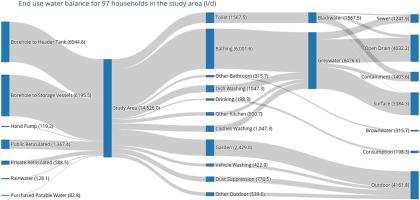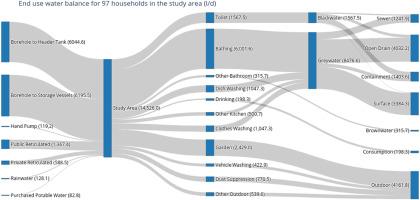柬埔寨暹粒市异质城市供水和卫生设施配置的住宅终端用水需求分析
IF 10
1区 环境科学与生态学
Q1 ENGINEERING, ENVIRONMENTAL
引用次数: 0
摘要
在低收入和中等收入国家,规划城市供水和卫生设施的一个主要限制是无法确定在难以计量的情况下已经存在哪些服务。本文展示了如何将住宅用水最终用途分析应用于模拟详细的无项目情况,并帮助确定与环境相关的最低成本干预措施。我们为柬埔寨暹粒市的异质基础设施配置提出了这样的最终用途分析。该分析从两个相邻村庄的14个点查区1630个按地理位置分层的家庭中抽取了97个家庭的最终用途消费数据。该研究表明,社会技术多样化的人口以高空间分辨率从各种服务提供类型和家庭基础设施中获得服务。采用半结构化调查问卷、观察方案和经验流量测量来收集最终使用参数数据(频率、持续时间、体积或流量)。我们的分析有效地分解了社会人口属性的每日人均需求,包括收入水平、家庭规模、使用权长度、不同的水获取类型和废水汇。这种自下而上的水平衡为识别、预测和比较可能的水和卫生选择对东南亚城市家庭的不同影响提供了灵活和包容的基础。本文章由计算机程序翻译,如有差异,请以英文原文为准。


Residential end-use water demand analysis for a heterogeneous urban water and sanitation configuration in Siem Reap, Cambodia
A major limitation in planning urban water and sanitation in low- and middle-income countries is the capacity to define what services already exist in contexts that are challenging to meter. This paper demonstrates how residential water end-use analysis may be applied to model a detailed without-project situation and help to identify contextually relevant least-cost interventions. We present such an end-use analysis for a heterogeneous infrastructure configuration in Siem Reap Municipality, Cambodia. This analysis sampled end-use consumption data from 97 of 1630 geographically stratified households from 14 enumeration zones in two adjacent villages. The study represents a socio-technically diverse population accessing services from a mix of service provision types and household infrastructures at a high spatial resolution. A semi-structured survey questionnaire, observation protocol, and empirical flow measurements were used to collect end-use parameter data (frequency, duration, and volume or flow rate). Our analysis effectively disaggregates daily per capita demand for socio-demographic attributes, including income level, household size, length of tenure, different water access typologies and wastewater sinks. Bottom-up water balances of this nature provide a flexible and inclusive basis for identifying, forecasting and comparing how possible water and sanitation options may impact urban households differently in a Southeast Asian context.
求助全文
通过发布文献求助,成功后即可免费获取论文全文。
去求助
来源期刊

Journal of Cleaner Production
环境科学-工程:环境
CiteScore
20.40
自引率
9.00%
发文量
4720
审稿时长
111 days
期刊介绍:
The Journal of Cleaner Production is an international, transdisciplinary journal that addresses and discusses theoretical and practical Cleaner Production, Environmental, and Sustainability issues. It aims to help societies become more sustainable by focusing on the concept of 'Cleaner Production', which aims at preventing waste production and increasing efficiencies in energy, water, resources, and human capital use. The journal serves as a platform for corporations, governments, education institutions, regions, and societies to engage in discussions and research related to Cleaner Production, environmental, and sustainability practices.
 求助内容:
求助内容: 应助结果提醒方式:
应助结果提醒方式:


